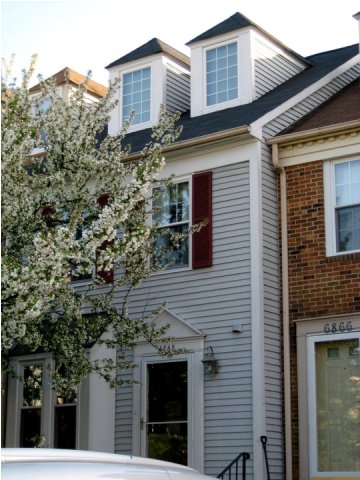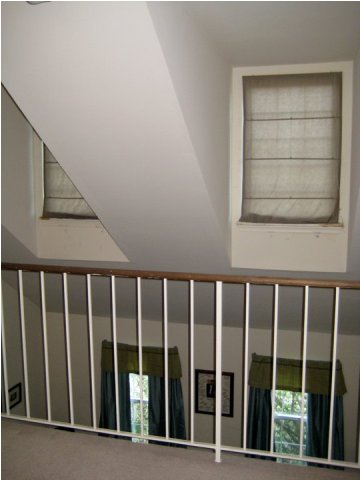
Christopher Moe, AC from Bladensburg (MD) and FF with Montgomery County (MD) Engine 2 sent in these pictures taken in Elkridge (MD.) The picture shows a common townhouse occupancy with dormers. Dormers always prompt an interesting discussion. How do you know when they are real and lead to a occupied space, or how do you know when they are only decorative? One of the most common responses to that question in more than likely: “knowing your area.” Obviously knowing your area is your best chance of figuring out the dormer question (or any other building construction question), but it’s never an absolute. As you can see below, these dormers “almost” lead to a occupied space. they lead to a loft, but the loft is set back from the dormers. This was done to allow the dormers to allow light in the loft area, and additional light for the second floor below. This could lead to quite a surprise to someone performing VES. (This is way the floor should be sounded before dropping in)

Well here is the twist to this one. Christopher used to live a townhouse very similar to this one, and the dormers lead directly to the loft area, without the drop to the second floor. So in this particular case, relying only on “knowing your area” would have let you down. Knowing your area is an essential part of being prepared for the job… Learning the trends in your local building construction can provide you with a tremendous amount of valuable information on the fireground. Just as importantly, this example proves that we should never rely on one source of information. We should use our preincident knowledge to assist us in making better decisions on the fireground, without blinding us from what we see right in front of our eyes.

WOW…Architect(s) and Building Department(s) THANK YOU for wasting our time!
and that, gentlemen, is why we always sound for a floor before entering.
Recognizing that neither of the those dormers have operable windows. While nothing is 100% it would be very rare for a live-able space to have its only 2 windows that can’t be opened. These are usually clues to vaulted spaces.
Rob, that may be the one of the best points anyone has ever made on here. That’s a long way down.
Hopefully most Departments utilize some sort of Warning Indicators on response tickets. We call them CIDS…Critical Information Dispatch System here. Gives all info one could use so as to be aware of situations such as this prior to arrival. If you don;t have one in place, this is a fine example as to why we need them. Little hints that go a long way.
We ran into this on the first fire I had at my new assignment a year ago. While performing a 360 of the structure, prior to making the roof for vert. ventilation, we saw that the main body of the fire was on the second floor on the Div C side. I took out the second floor windows with a pike pole only to hear the glass fall all the way down to the first floor. It is then I realized it was a great room with cathedral ceiling.
@ Brian Brush,
Thanks for mentioning that nothing is 100% certain…those windows could very well be operable casement style windows…no way of knowing from the outside.
http://www.floridasbestwindow.com/products-casement-windows/large-image/
If you notice one detail about the windows? They DO NOT open, all windows in bedrooms will open is some fasion Be safe out there Brothers and Sisters
With regard to the “non-opening” window analogy. At 3am while a top the aerial with smoke pushing there is no way to know those windows are stationary. Also, depending upon SOP’s the LCC may utilize to tip of the aerial to vent the upper floors as we do here depending upon the occupancy and construction type. In general they look like casement styled windows from the ground where the photo was taken. The only way to know is by pre-planning or sounding for a floor once vented prior to entry.
You know, everyone always makes a reference to fires at 3 a.m. Does every fire happen at 3 a.m.?
I dont think so, most have mine have been between 145 and 215 am..nothing has gone wrong so I guess its a good time for fires to happen.
the old 3 am saying is actually misleading because a majority of accidents happen at mid day events when members become complacent. At a 3 am fire, most members are a little more on their toes and looking for this kind of stuff, from what I have seen. It’s the “bread and butter†fires that take you out
“the old 3 am saying is actually misleading because a majority of accidents happen at mid day events when members become complacent. At a 3 am fire, most members are a little more on their toes and looking for this kind of stuff, from what I have seen. It’s the “bread and butter†fires that take you out”
Please tell me where you got this info. Fire Engineering, NIOSH, OSHA? Complacency has nothing to do with time of day.
I was just f’ing with you, guys. I use the old “3 a.m.” saying all the time. I just think it’s funny that we all do it. I just think it would be interesting to see how many actually happen at 3 a.m. So simma dahn nah!
At 3 am, I’m usually trying to get the crust out of at least one eye.
I also like the irony of someone posting a “those windows DO NOT open” comment right under my link for residential casement windows.
I see a lot of talk about similar set ups that have window that don’t open. In this particular case, these windows DO open. As a matter of fact, my neighbors routinely use their “window pole” to open them in the spring and fall months in order to have some air movement in their bedroom. So when you arrive, whether it be at 3pm or 3am, and notice a window open, your first thought would be that they lead to a bedroom with a floor below.
Thanks for all the comments though, it keeps us thinking.
Im a volly that runs this first due in elkridge, we have ran a working fire an this complex before and actually encounterd this issue, thankfully we sounded the floor before entry, otherwise we would have had a problem